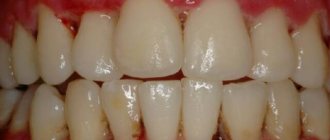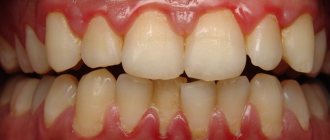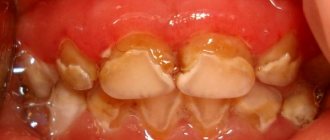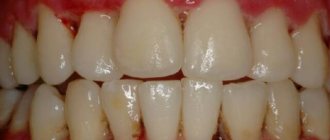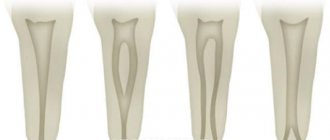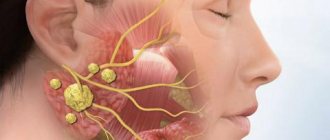Have questions?
Gingivitis of the gums is an inflammatory process of the mucous membrane. If not diagnosed promptly, it can develop into periodontitis, a serious inflammation of the gums that affects the surrounding tooth tissue.
Gingivitis of the gums is an inflammatory process of the mucous membrane. If not diagnosed early, it can develop into periodontitis, a serious inflammation of the gums that affects the surrounding tooth tissue.
According to the World Health Organization, 90-95% of adults experience signs of acute or chronic gingivitis at least once in their lives. At the same time, tooth loss due to gum inflammation occurs five times more often than as a result of caries.
Reasons for the development of the disease
The main factor in the development of inflammation is insufficient oral hygiene, due to which microbial plaque thickens and forms into tartar.
Teenagers and pregnant women are most susceptible to the disease due to hormonal changes in the body. Also at risk are people with diagnoses such as:
- diabetes;
- avitaminosis;
- HIV;
- leukemia;
- diseases of the digestive tract.
Even minor trauma to the oral mucosa becomes a favorable environment for the development of infection. That is why congenital malocclusion, unpolished fillings, sharp edges of dentures, as well as using a hard toothbrush and eating hard foods can lead to gingivitis.
Treatment of the disease
Treatment of chronic catarrhal gingivitis involves a set of measures aimed at eliminating the already emerging consequences of the disease, as well as the causes that caused it. Typically, it begins with a professional teeth cleaning at the dentist's office.
The course of treatment is selected individually and depends on the form, severity and nature of the disease. Often the patient is prescribed mouth rinsing with antiseptic solutions and the oral cavity is sanitized. It involves treating caries, filling teeth, and replacing incorrectly installed fillings. This approach eliminates the possibility of relapse of the disease in the future.
Drug therapy consists of treating the oral cavity with antiseptic solutions and applications of special ointments. When treating the chronic form, it is possible to massage the gums.
It is worth noting that treatment is often carried out in combination with a diet that excludes foods that irritate the gums and is rich in vitamins A, B, E.
Treatment of chronic catarrhal gingivitis of any severity has been successfully carried out by dentists at the CELT clinic for several years now.
Symptoms of the disease
Signs and symptoms of gingivitis vary depending on the type of inflammation of the mucous tissue. Common signs include:
- swelling, pain and redness of the gum tissue;
- the appearance of blood when brushing teeth or eating;
- pungent odor from the mouth.
With further development of the disease, the necks of the teeth may be exposed, which provokes an increase in their sensitivity - the person experiences discomfort while eating hot and cold foods and drinks.
The consequences of gingivitis are quite serious. So, when inflammation spreads to the ligaments that hold the teeth, periodontitis develops. In turn, this type of complication provokes active mobility of the teeth, and then leads to their loss.
Inflammation of the gums: Gingivitis
Gingivitis (lat. gingivitis) is inflammation of the gums without compromising the integrity of the dentogingival junction. If left untreated, gingivitis can progress to the destructive form of periodontal disease called periodontitis. Etiology Actinomyces israelii is one of the types of microorganisms that cause gingivitis Gingivitis usually occurs due to the accumulation of microbial plaque on the teeth as a result of poor oral hygiene. Gingivitis can also be caused by improper orthodontic treatment, which, in combination with poor dental and oral care, provokes the intensive development of pathogenic microorganisms. Bacteria (less commonly, viruses, fungi) are the direct cause of gum inflammation (Streptococcus oralis, Bacteroides gingivalis, Porphyromonas gingivalis, Actinomycetes comitans, Prevotella intermedia, Actinomyces israelii).
Risk factors: – tobacco smoking – poor oral hygiene – immunosuppressive conditions – lack of access to adequate dental care – malnutrition – tartar – age from 3 to 6 years – diabetes mellitus – pregnancy – vitamin C deficiency – depression – acute respiratory infections, flu, sore throat, AIDS, tuberculosis and other diseases – poisoning of the body with heavy metals (mercury, bismuth, lead) – use of oral contraceptives – malocclusion – problematic fillings – impaired nasal breathing
Classification and symptoms of gingivitis
- Acute catarrhal gingivitis is the most common form of the disease. The main symptoms are redness, slightly swollen gums, and often soft and hard deposits on the teeth. When brushing your teeth, gum inflammation and bleeding may occur.
- Catarrhal gingivitis Catarrhal gingivitis is the most common form of the disease. The main symptoms are redness, slightly swollen gums, and often soft and hard deposits on the teeth. When brushing your teeth, gum inflammation and bleeding may occur.
- Chronic Chronic gingivitis is characterized by the fact that the patient experiences virtually no pain, and the inflammation itself has a long, sluggish course. Therefore, chronic gingivitis is often discovered only during routine dental examinations. During chronic gingivitis, bleeding periodically occurs when brushing teeth, bad breath appears, slight redness of the gums and swelling of the gingival papillae occurs. As the disease worsens, the gums become brightly colored, swell and bleed. The presence of dental plaque is noted, sometimes with damage to the hard tissues of the tooth.
- Desquamative gingivitis is characterized by intense redness and abundant desquamation of the gingival epithelium.
- Hyperplastic gingivitis Hypertrophic (hyperplastic) gingivitis occurs in more rare cases and is often associated with endocrine changes in the body. This type of disease can occur in adolescents (juvenile gingivitis), pregnant women and people with diabetes. With hypertrophic gingivitis, the volume of the periodontal papillae increases. When the disease occurs, bleeding occurs, pus is discharged, the gums become purplish-bluish in color, an unpleasant odor, dental deposits appear in the mouth, and false pathological pockets form. For hypertrophic gingivitis, the severity is determined by the severity of gingival hyperplasia: with a mild degree - up to 1/3. with moderate degree - up to 1/2 and with severe degree - more than 1/2 of the tooth crown.
- Simple marginal Most common in childhood and associated with poor oral hygiene.
- Ulcerative Characterized by severe itching, burning, bleeding and ulceration of the gums.
- Atrophic gingivitis is characterized by a decrease in the volume of gingival tissue.
- Acute necrotizing ulcerative gingivitis is classified separately in ICD-10. The cause of the disease is a bacterial infection, most often anaerobes such as P. intermedia, fusobacteria, and spirochetes such as Borrelia and Treponema. The oral mucosa becomes inflamed, bleeding appears, an unpleasant odor appears, and necrosis of the interdental papillae occurs. The disease occurs with insufficient oral hygiene in young people (17-30 years old). It can occur with acute respiratory infections, flu, sore throat, AIDS, tuberculosis and other diseases.
Treatment of gingivitis Depending on the course of the disease, appropriate treatment is carried out, which may consist of both professional cleaning of the oral cavity and surgical treatment. In case of severe or protracted gingivitis, systemic use of antibiotics such as penicillin, tetracycline, doxycycline, metronidazole, ciprofloxacin, clindamycin is possible. Paracetamol or ibuprofen is used to relieve pain.
Prevention – maintaining oral hygiene (toothpastes, gels, rinses) – stopping smoking – using electric toothbrushes – dental gels with metronidazole, for example “Metrogil Denta” – ambazon, 2,4-dichlorobenzyl alcohol, amylmetacresol in the form of lozenges – rinsing the mouth with solutions containing chlorhexidine, hydrogen peroxide, ethanol, thymol, cineol, methyl salicylate, menthol, methylparaben, benzalkonium chloride, fluorides and xylitol. Recent scientific studies have also shown the beneficial effects of mouthwashes with essential oils - the use of toothpastes with triclosan - the use of calcium supplements The above preventive measures are also used for treatment. The use of dental floss is not advisable.
Types of gingivitis
To determine treatment tactics, it is necessary to identify the type of disease. Each of them differs in clinical manifestations and therapeutic direction:
Catarrhal
The most commonly diagnosed type. With catarrhal gingivitis, only the mucous membrane of the gums suffers, and the following are characteristic:
- itching;
- bleeding gums during oral hygiene;
- swelling of the gum tissue.
Such manifestations of gingivitis occur against the background of endocrine diseases, malocclusions, decreased immunity, and also due to injuries to the mucous membrane.
Ulcerative
It is a severe form of the disease. Ulcers appear on the oral mucosa, they hurt, bleed and cause bad breath. With this type of inflammation, it is possible that the body temperature may rise to 39 degrees. The problem is diagnosed in people with malocclusions, autoimmune diseases, and chronic stress.
Hypertrophic
Gum tissue begins to grow in the patient’s mouth, and keratinized areas of the gums appear. The first signs of the development of the disease are:
- discomfort when eating;
- swelling of tissues;
- burning in the mouth.
Often, such gingivitis occurs in people with malocclusion, endocrine system disorders and vitamin C deficiency.
Atrophic
Characterized by a reduction in gum volume and exposure of the dental neck. In the future, it can lead to exposed roots. Other signs of inflammation are most often mild - the patient only has a painful reaction to eating hot and cold food. The atrophic form develops in people with weakened immunity and impaired metabolism.
Desquamative
It is manifested by increased desquamation of the gum epithelium - ulcers form in the patient’s mouth, the gums become red. As a rule, the disease occurs in diabetics and people with gastrointestinal problems.
Gingivitis - symptoms and treatment
The development of gingivitis begins with the formation of plaques from dental plaque. They form after lack of proper oral hygiene for 1-2 days. The most common places for plaque formation are interdental spaces and the cervical area.
A film called pellicle is formed from saliva and fluid secreted by the gums. Normally, it performs a protective function, but in the initial stages of gingivitis it promotes the adhesion (sticking) of bacteria that are present in the oral cavity even in a healthy person. Usually these are aerobic cocci and rods.
Microorganisms actively reproduce, and an anaerobic (oxygen-free) environment is formed in the depths of their colony. This creates optimal conditions for the proliferation of aggressive gram-negative microflora. These bacteria produce toxins that can penetrate tissue and destroy the mucous membrane, which leads to erosive changes in the epithelium.
The body tries to resist the damaging effects and in response launches an inflammatory reaction to destroy pathogenic factors. In some cases, the immune system copes with the microflora on its own, but more often the inflammation progresses or becomes chronic.
The destructive effect of microorganisms and the inflammatory process lead to deterioration of microcirculation in the gums and a decrease in the activity of antioxidant defense mechanisms. This leads to an aggressive effect on the epithelium of complement system factors (protective proteins circulating in the blood), which causes progressive destruction of the mucosa. In patients with immune defects, hormonal disorders, blood diseases, traumatic damage to the gums and thinned mucous membranes, soft tissues are more vulnerable, and the process of their destruction is more active.
If the pathological process is actively developing, the number of immune system cells (lymphocytes and macrophages) increases in the soft tissues. They destroy cells and fibrillar structures of the cytoplasm (rigid, parallel fibers that determine the shape of the cell). This leads to expansion of the space between the gum and tooth, thinning of the epithelial layer.
Inflammation can go away completely with the onset of recovery, or become chronic. In the second case, the regeneration processes are disrupted, the epithelium is replaced by granulation tissue (connective tissue that is formed during the healing of tissue defects), which can grow greatly, covering the tooth crown [4].
Diagnostics
Signs of inflammation can be determined visually. However, to exclude a number of other serious pathologies, the diagnosis of gingivitis includes a number of additional procedures:
- collecting anamnesis, checking the condition of dentures and braces in the mouth;
- probing of gum pockets (if any);
- determination of tooth mobility;
- panoramic X-ray or targeted X-ray - to exclude periodontitis and periostitis.
During the diagnosis and subsequent treatment of gingivitis in adults and children, the presence of other diseases, as well as the use of medications, is taken into account - you must inform your doctor about them.
Recommendations after treatment
To avoid the occurrence of catarrhal gingivitis after treatment, you need to follow 7 rules:
- Lead a healthy lifestyle and support your immune system. Consume a vitamin-mineral complex and a sufficient amount of proteins, carbohydrates and fats.
- Prevent the transition of chronic diseases to the acute stage. Treat chronic diseases of the cardiovascular and hormonal systems, gastrointestinal tract.
- At least 2 times a year, carry out professional cleaning of the oral cavity to remove soft and hard plaque and prevent the formation of tartar.
- Use a toothbrush with medium hardness. Too soft does not sufficiently clean teeth from plaque, and hard ones can injure the enamel and cause pain with high sensitivity.
- Properly clean the oral cavity and the space between the teeth using floss and irrigator.
- Visit the dentist regularly in order to promptly detect inflammatory processes and eliminate them at an early stage.
- Choose the right toothpaste with sodium, fluoride, potassium nitrogen and other components. Entrust this task to your doctor.
If you follow these recommendations after treatment, you will confidently avoid a recurrence of catarrhal gingivitis.
Make an appointment through the application or by calling +7 +7 We work every day:
- Monday—Friday: 8.00—20.00
- Saturday: 8.00–18.00
- Sunday is a day off
The nearest metro and MCC stations to the clinic:
- Highway of Enthusiasts or Perovo
- Partisan
- Enthusiast Highway
Driving directions
How to cure gingivitis?
Most often, patients turn to the dentist with signs of acute inflammation. In this case, the treatment of acute gingivitis is complex and includes several stages:
- Removing plaque and tartar.
- Taking anti-inflammatory and antibacterial drugs.
- Teaching proper oral hygiene.
If the gums have grown too much in the mouth or have exposed the tooth roots too much, surgery cannot be done without it. At the same time, it is possible to solve the problem under the guidance of a good dentist even in this case - with proper treatment, the tissue will be restored in a few weeks.
The insidiousness of the disease is that in the first stages there is a great temptation to interrupt the course of treatment when the symptoms of gingivitis become less pronounced. This mistake is often made by patients who decide to cure the disease at home. Our doctors advise not to do this and to maintain a systematic procedure. Otherwise, there is a risk of complications and the development of chronic gingivitis.
Gingivitis in pregnant women
Inflammatory processes in pregnant women are especially common.
This is explained by changes in hormonal levels and a decrease in general immunity. This leads to impaired blood circulation in soft tissues, which increases the risk of inflammation. The gums become more sensitive, swelling and pain appear. As a result, pregnancy gingivitis is observed. Gum pathologies first appear at 8-12 weeks of pregnancy. It is noteworthy that in women, catarrhal and hypertrophic forms are more often detected.
Therapy for the disease is only local, since systemic drugs can negatively affect the development of the fetus. For this reason, treatment should be started at the first signs of the disease, and close attention should be paid to prevention.
Treatment of gingivitis
Determining how to treat gingivitis in a particular case is the prerogative of a specialist doctor who can objectively assess the clinical picture, make the necessary diagnostics and choose the right treatment tactics. That is why we recommend that you contact our dentistry in Moscow, and not experiment on your body, going through medication options and dosages, trying to cure gingivitis on your own. The specialists of our clinic, thanks to their experience and the availability of modern equipment, can cure acute gingivitis in 10-14 days, but if you allow the chronic stage, the treatment will inevitably take months.
It is the specialist who must determine what treatment tactics need to be used, which will depend on a number of factors:
- Forms of the disease;
- Anthropometric data: age, weight, gender, height;
- Causes of pathology;
- Neglect and severity of the disease.
Certain groups of patients should strictly self-medicate, so if gingivitis occurs in pregnant or lactation women, specialists from two fields will work on treatment: dentistry and gynecology. The prescription of each drug is double-checked taking into account the woman's specific situation, and only topical drugs are used as a means of treatment. Indeed, regardless of the degree of risk of harm to the child, with gingivitis it will always be higher than the potential benefit to the woman’s body. This does not mean that gingivitis does not need to be treated during this special period; the damage to women’s health may be irreversible, which means it needs to be treated, but it must be done correctly.
Children's gingivitis is treated with complex therapy, which includes treatment tactics similar to those for adults; dentistry is supplemented by control of teeth brushing and a bite check by an orthodontist. It is the orthodontist, in conjunction with the attending dentist, who becomes the guarantor of the development of tactics for the rapid recovery of the oral cavity and the suppression of further relapses. While doctors carry out treatment and the baby is observed by them, many parents abdicate responsibility, which is wrong. They play an important role in the treatment of the baby, help the child comply with the developed dental regimen, and they are the ones who carry out the mandatory home instruction for the baby. Father and mother are socially significant individuals, so their behavior will shape the child’s behavior and whether the prescribed therapy will actually be used.
Catarrhal gingivitis
In terms of severity, it is defined as a mild form of pathology; accordingly, the lesion concerns only the interdental papillae, which enlarge and take on a dome shape. Among the main symptoms of catarrhal gingivitis of the gums, the patient experiences swelling, burning and redness of the gums.
For this form of gingivitis, it is recommended to use local therapy, including rinses, antibacterial ointments, treatment of associated diseases, and preventive measures.
IMPORTANT! “When choosing painkillers, they prescribe drugs whose main active element is lidocaine, which “kills two birds with one stone”: the rate at which local painkillers reach an effective plateau for this pathology is higher, local drugs do not harm the digestive system.”
Causes
External or internal factors can stimulate the inflammatory process in tissues, including:
- injuries to mucous membranes and teeth;
- cervical caries;
- anomalies of the dentition and soft tissues of the oral cavity;
- inadequate hygiene;
- sharp edges of the filling, incorrectly fixed braces or dentures.
The causes of catarrhal gingivitis can be supported by additional factors - problems with the thyroid gland, viral infections, blood pathologies and other disorders that increase the risk of developing inflammation several times.
Diagnostic methods
A visual examination by a dentist may be sufficient to assess the disease. If symptoms are severe, the doctor may refer the patient for an x-ray. This is necessary if infection of the pulp, periodontal and bone tissue is suspected.
In the presence of ulcers or chronic inflammation, a microbiological analysis is performed, which identifies the type of bacteria and their resistance to antibiotics. If a generalized form is diagnosed, then additional diagnostics are carried out by relevant specialists: ENT doctor, gastroenterologist, immunologist, and other specialists. The patient donates blood for general tests, sugar, HIV infection, syphilis.
Nutritional Features
The diet is calculated taking into account the height and weight of a person, as well as his physiological characteristics: fat content, percentage of water, etc. The thermal index of foods should be biased towards the protein. Fats and carbohydrates are calculated according to the lower acceptable coefficient, because it is the products containing them that form soft plaque. We also shouldn’t forget about fiber, because products containing it contain many vitamins:
- C – citrus fruits, currants;
- Micronutrients and pectin – pears, apples;
- A, C, K – blackberry;
- B, C – raspberries;
- carotene, phytoene, phytofluene, calcium, magnesium, phosphorus - carrots;
- A, B1, B2, B5, B6, B9, C, PP, boron, vanadium, iodine, iron, potassium, calcium, magnesium, manganese, copper, sodium, zinc, phosphorus - beets;
- Etc.
A doctor creates a complete diet; only he can, depending on the patient’s budget or season, replace natural vitamins with medical complexes or dietary supplements.
Prevention
Prevention is better than cure - this is the golden rule of medicine, so follow the rules of hygiene dictated by common sense, teach this to your children:
- Regular teeth cleaning;
- The choice of the type of brush and paste is made by the doctor;
- Visit your dentist twice a year;
- Don't forget about fiber in your diet, it cleans not only your teeth, but also your intestines.
Do not forget that a sanitized oral cavity is the key not only to healthy teeth, but also to the performance of all systems of the human body, because we are what we eat. If you have any difficulties with your dental health or are interested in other materials developed by our specialists in the field of dentistry, visit the website, where you can also read comments from people who have already undergone treatment in our clinic.
Classification of the disease
There are several classifications of the disease that separate typical pathologies according to a certain criterion; ICD 10, recognized by the world medical community, applies classification according to the form of the disease.
So, according to the frequency of gum gingivitis, it happens:
- Acute – characterized by the presence of pronounced pain that is permanent. Other signs, such as bleeding and inflammation, are also increased by a multiple of the pain effect.
- Chronic – has a cyclical nature, balanced with annual natural cycles, so the pathology manifests itself during periods of reduced intake of vitamins and subsides when it is increased.
The severity is divided into:
- Mild – when gingivitis is located around the teeth, affecting the interdental papillae;
- Medium – the colony grows, pathogenic microorganisms continue to inflame the tissue, as a result the affected area expands to the free gum;
- Severe – when all soft tissues of the gums are affected, including alveolar ones.
According to the degree of localization, the pathology is:
- General - the lesion affected the area around all the teeth of one or both jaws;
- Local - the epicenter of the development of pathology becomes a part of the teeth: one or several scattered ones.
The main classification of the disease by form offers the following types of pathology:
- Ulcerative-necrotic;
- Atrophic;
- Hypertrophic;
- Catarrhal.
Ordinary gingivitis in adults differs from the course of the pathology in specific patients, therefore they are divided into separate groups, the special conditions for which are:
- Pregnancy;
- Childhood/adolescence.
